Listening, Hearing, and Improvising in Knoxville, TN: Big Ears Festival 2017

This edition of “Notes from the Field” showcases the incredible number of eclectic musical activities that occurred during the Big Ears Festival in Knoxville, TN, in March of 2017. The ample videos and photos give a sense of the magnitude in quality and quantity of performances.
Rather than trying to smother the audience with a contrived “experience” such as Lollapalooza, Coachella, Bonnaroo or other major festivals, Big Ears allows the audience to choose their own path in Knoxville’s medium sized downtown. Knoxville is a place with a thriving community arts scene that is no stranger to outside influences. What follows is meant to give a sense of the chronological musical experience from two perspectives as the co-authors Otto Stuparitz and Helga Zambrano did not follow exactly the same path.
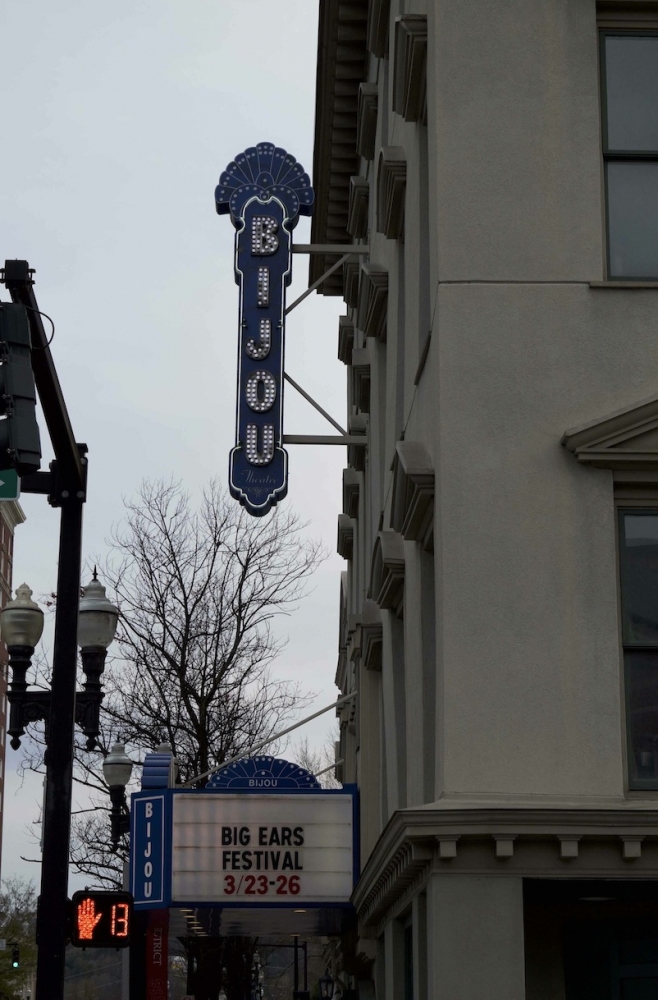
Figure 1: Outside the historic Bijou Theatre, built in 1909, where acts like Henry Grimes and Meredith Monk performed during Big Ears.
It’s hard to succinctly describe the artists at Big Ears 2017. Living up to its name, the festival boasts a wide-ranging lineup and demands broad taste from every attendee. While major popular music acts like Wilco, My Brightest Diamond, and the Magnetic Fields grace the top billing and largest theatres at the festival, many of these musicians also perform in unique solo or small group settings with alternative and adventurous musical goals. These smaller sets are sometimes official side projects while others are adhoc blendings of musicians wanting to present open forms of jazz, noise, electronic, minimalism, metal, and fusion.
I (Otto) first attended this festival in 2013, curated by Steve Reich, and which featured Television, John Cale, Julia Holter, Low, and Radiohead's Jonny Greenwood. Greenwood performed Reich’s “Electric Counterpoint” as well as his string based film scores. But the 2017 lineup moved away from this art-rock starting point now including more contemporary classical and non-standard jazz. This year’s occasion also seemed to put the themes of improvisation, listening, and freedom more frontally focused, while leaving the specific interpretation in the hands and ears of each artist.
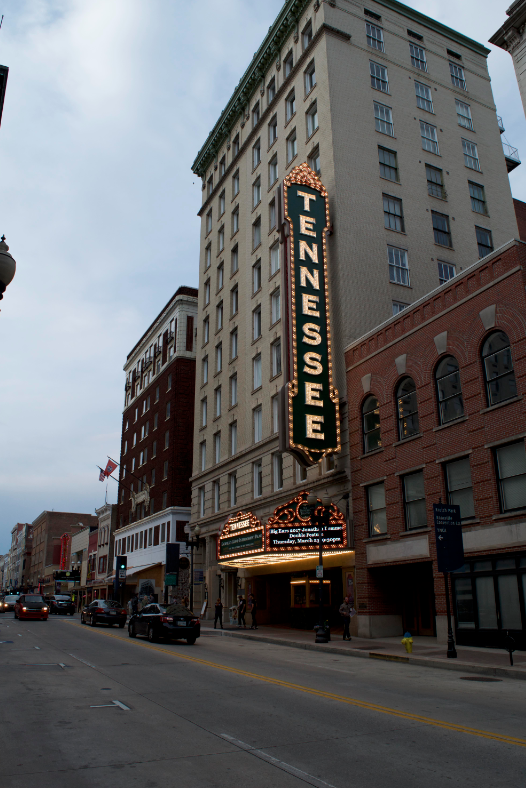
Figure 2: Outside the Tennessee Theatre where popular acts like Wilco, My Brightest Diamond, and the Magnetic Fields performed.
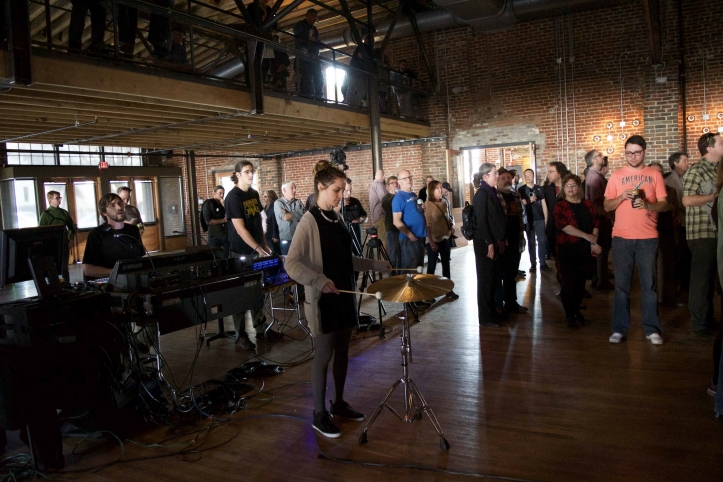
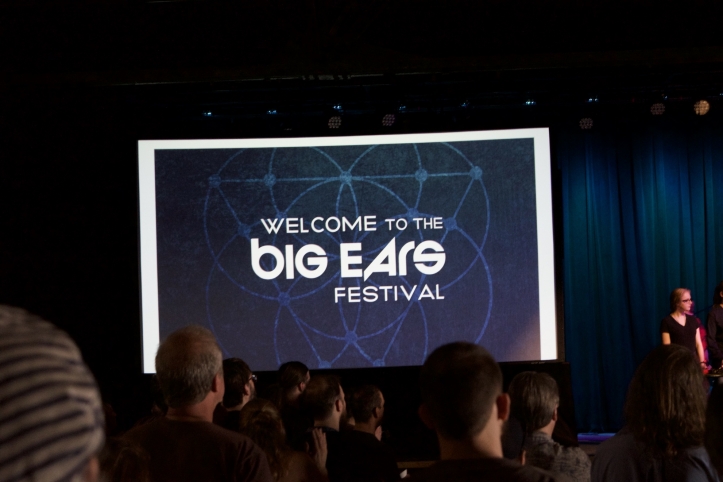
Figure 3/4: The opening celebration featuring Neif-Norf percussion ensemble performing Pauline Oliveros’ Single Stroke Roll Meditation, commemorating her recent death.
Opening Event: The Spectre of Pauline Oliveros
At the opening event, a succession of speakers promoted the festival’s role in local arts education. This festival has funded many local arts education initiatives and has been an avenue to bring different kinds of music making to the Knoxville area. One speaker, citing the Ford Foundation, said, “without arts there is no empathy, and without empathy there is not justice.” I took this to mean that Big Ears is not just an aural phenomenon, but is also meant to engender some sort of commensurate social meaning. An example of these efforts were demonstrated in the next presentation as a local all female percussion group performed an original composition based upon their experiences at Big Ears in previous years. The piece began with a series of grooves and finished with a meditative rhythmic drone.
This year did not feature one primary curator like previous years such as Philip Glass, Terry Riley, Steve Reich, and John Luther Adams. Rather, this year began with an homage to recently departed Pauline Oliveros as her spirit was asked to preside over the festival. As the meditative drone of the local percussion ensemble faded, Nief-Norf began Pauline Oliveros' composition Single Stroke Roll Meditation; a piece featuring an intensifying soft mallet roll on a single ride cymbal while three other performers on opposite sides of the giant room with simple percussion setups slowly built their own atmospheres. As the volume grew, the cymbals and percussion blended with the sounds of the industrially converted loft, the crowd murmurs, and the bar sounds. It was a large collective breath as the audience was asked to listen to the room and listen to themselves. We began the festival with an exercise to open our ears.
Neif-Norf reconvened in the center of the room to perform Michael Gordon's Timber, a piece with instructions on how to make sonic waves with mallets on blocks of wood. The punned titled piece explores the timbral shading on different ends of timber blocks, as each performer’s pulses blended polyrhythmically with the other performers. Unlike the Oliveros piece, this piece was more mechanical, emphasizing a technological path to music making that had less to do with the space and people of the performance and more to do with the technical prowess of the composition and performers.
Video 1: Opening ceremony with the wood block composition “Timber” by Michael Gordon at the Mill and Mine.
Taking in this opening event, the musical themes were part of the avant-garde, but a certain kind of avant-garde. There was listening, there was hearing, there was improvisation but all in a certain way. The music seemed to relate to the “Eurological” perspective of improvisation as described by George Lewis (1996), a term intended to historicize the particular characteristics of certain musical systems. The Euro-American “Eurological” can be traced to Henry Cowell’s institutionalization of “ultra modernism” through his founding of the New Music Society in 1925 that later included noted experimentalists such as John Cage and La Monte Young. Musics called “avant-garde,” “experimental,” “jazz,” “contemporary classical,” “minimalism,” and many of other terms are imperfect for complicated works with complicated cultural positions.
Lewis’s contrasting term,“Afrological,” can be traced to LA’s mid-century Central Ave scene, which moved to Watts and Leimert Park in the 1960s. The notable musics of Horace Tapscott’s UGMAA, Pan Afrikan Peoples Arkestra, and the beginnings of free jazz with Ornette Coleman, Eric Dolphy, and others all fall under Lewis’s term. Lewis respectively identifies John Cage and Charlie Parker as representatives of the Eurological and Afrological approaches, whose differences turn on their attitude toward the expression of race, ethnicity, class, and political ideology in music.
In this conception, Lewis understands Eurological improvisers as tending to look warily on the admission of personal narrative into improvisatory activity. Following Cage, Eurological improvisation should not be descriptive of the performer, but is descriptive of what happens (Lewis 1996:118). When this happens, performers identities are muted. In this context, who is the audience listening to? Who is in charge? Is this freedom to openly listen and explore as neutral as this festive event makes it seem? Practically speaking, who are these open spaces open to?
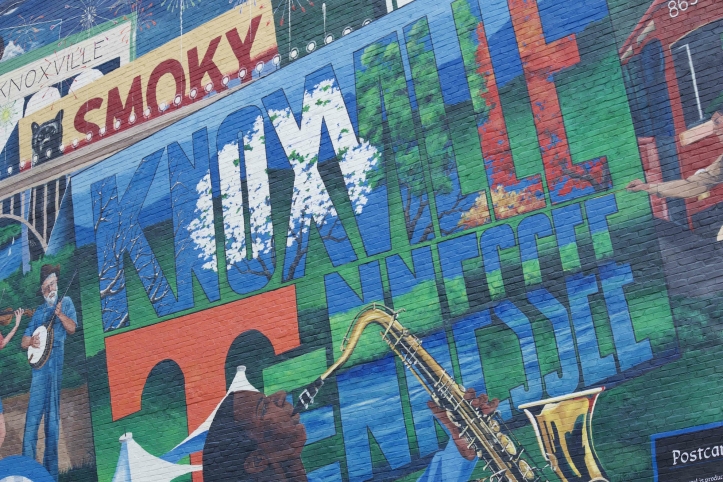
Figure 5: Mural from downtown Knoxville featuring a saxophonist and a banjo player against the backdrop of the nearby Great Smokey Mountains.
The mid-sized city of Knoxville served as an open public space for the festival, facilitating an illusion of neutrality, fluid movement, communication, and self-organization within its city walls. Made up of well-groomed boulevards, a market square, and ample parking, this Tennessee city grid invited festival-goers to take lazy walks through town. When heading between concert venues, festival-goers could wander into their theatres, restaurants, breweries, and mom-and-pop shops all lined up in a row. But as prompted by Otto, is this freedom privileged to concert-goers only, or is it open to all? Descriptive to the festival experience, Knoxville served as the event’s foreground and background narrative, where the city and the festival were harmoniously blended to evoke a community-centered, civically engaged, socially equal, music-sharing experience--as long as the cold beers were still served in abundance.
Day 1

Figure 6: Matana Roberts performing at the Square Room.
Matana Roberts put on an appealing set of mixed visuals with vocal and saxophone loops. She addressed the audience succinctly as she moved to fill the room with an ambient clash of choked notes, audible breathing, and enigmatic poetry. She was a powerful force early in the weekend, demonstrating how noise and melody could be melded.
Video 2: Matana Roberts performing at the Square Room.

Figure 7: Matana Roberts performing at Jem Cohen’s Gravity Hill Sound+Image event, a live improvised score of many of the festival’s musicians with the images projected onto an eight-story building.
Her last performance in the festival, at Jem Cohen’s Gravity Hill Sound+Image event, was one of the few events that attempted to bring the many musical worlds together. Roberts listened to her fellow musicians and the echoing space of the parking lot. It was a performance only possible for that moment and in that space. Her solo looped improvisations gave way to Xylouris White’s Greek inspired free-jazz and local bluegrass fiddlers. As the musicians listened and played together, it reminded me of the festival’s opening event and the goals of the festival as a space for empathy and justice. This time the musicians were open not only to the audience and the sounds of the environment, but also to one another.
Video 3: Xylouris White’s Greek inspired free-jazz at Jem Cohen’s Gravity Hill Sound+Image event.
Video 4: Claire Chase playing a bass flute with live electronics.
Claire Chase’s performance on bass flute and concert flute featured what most classical concert flautists are trained to conceal: the unruliness of breath. As a flautist myself (Helga), I have been trained to control my diaphragm, shape my embouchure just right, and manipulate with care my airstream so as to produce crisp, bright, and pure tones. As a result, this form of praxis creates a sonic illusion of a breathless tone, categorizing the breath as a blemish; the quivering inhale or exhale through the mouth and nose are immediately streamlined into gentle vibratos or a clean airstream.
Chase’s performance contemplated this otherwise discordant sound in order to bring to the surface the intimate correlation between the body, the breath, and the woodwind instrument. More significantly, Chase urged the listener and the flautist to revalue the human body’s most cherished substance for life (the breath) as a source for musical creativity and performance, rather than as a performative hindrance.
Chase’s fluting cross-pollinated a range of breathy sounds that explicitly engaged with the voice, the nasal cavity, the throat, and the diaphragm. Moreover, her body aggressively swayed on the stage, demonstrating that her flute performance also depended on choreographic gestures to create these sounds. Drawing from her diaphragm Chase created guttural, croaky, growly, scratching, gravelly sounds. She also drew from the mouth to evoke wispy sounds, gusty wind howls, whispers, and susurrations--an effect that displaced the flute tone from the foreground to the background. At another point in her performance, Chase tapped into the vibrations of voice, intermixing a hum, a buzz, and a mumble to the flute’s tone. And in more classical flautist maneuvers, she used her tongue to create trills and clicks.
The flute-sounding process, rather than the performative outcome, served as the driving motive for Chase’s performance. More importantly, it challenged the ontology of classical flute music and reset the expectations of the listener and the hearer. Through Chase’s techniques, the flute was unbound and released from its romantic forecast. As a result, her solo flute work opened up a discursive and creative space to expand the praxis capacities of a woodwind instrument and for the musician and vocalist more broadly.
Day 2
Meredith Monk seemed to be the unofficial curator of the festival as she performed with a variety of ensembles throughout the extended weekend. Her events were well attended and she seemed to strike a balance between venerated classical icon and free moving participatory performer. She mixed sound with music and choreography to create captivating performances featuring some of her “hits” as well as new lesser-known works.
Video 5: Meredith Monk performing a piece written in and inspired by the music of Native American tribes from Central New Mexico.
Video 6: Meredith Monk performing her 1986 piece, Scared Song. She introduced it as important work she remembers in times of political of darkness.
Video 7: Excerpt of Meredith Monk’s mini staged opera, Atlas, with khaen a Lao/Northeast Thai mouth organ.
Arrington de Dionyso’s surprise set was a breath of fresh air. I met Arrington de Dionyso the summer before in Los Angeles when he was touring a film, which featured experimental music interacting with an Indonesian possession music called reak.(Reak: Trance Music and Possession in West Java- https://www.youtube.com/watch?v=L2WeaWMEqAM). I did not realize it was Arrington until I arrived, since the band was billed as “This Saxophone Kills Fascists,” a cause with a glaring Woodie Guthrie reference. I later found out that Arrington’s tour was an anti-Trump protest, as Arrington was tangentially related with the #Pizzagate incident. He had been targeted by 4chan trolls and #pizzagate conspiracy believers because some of his art hung on the walls of the DC pizza restaurant and music venue, Comet Ping Pong. Rather than fall victim to these threats, Arrington responded with a “This Saxophone Kills Fascist” tour. This article and tour promotion explains more of the details of #pizzgate and Arrington’s response to it. https://www.tinymixtapes.com/news/pizzagate-victim-arrington-de-dionyso-tour-us-spring-saxophone-kills-fascists)
The group was introduced at the end of the show, to reveal to the audience that the performers did not know each other. Rather, it was an adhoc combination of local and touring musicians. It felt like the most raw and openly political event of the festival with the musicians interacting on stage, creating a shared sonic space with a political basis. And just as quickly as it arose, the crowd dispersed to get back to the regularly planned programing.
Video 8: This Saxophone Kills Facists, Arrington de Dionyso with an adhoc group of musicians featuring a local Knoxvillian saxophonist and bassist and Deerhoof drummer Greg Saunier.
Day 3
The Big Ears Festival featured poets and filmmakers as well. Kevin Jerome Everson’s short films were presented at the Knoxville Museum of Art featuring: Ring (2008), Tygers (2014), Auditioning for Nathaniel (2016), R-15 (2017), Smooth Surface (2015), Production Material Handler (2015), Fe26 (2014), and Ears, Nose and Throat (2016).
I was particularly drawn to Everson’s R-15, Smooth Surface, Production Material Handler, and Fe26, which emphasized the interconnected process between industrial production, the physical exertion (and exhaustion) of the body, race relations, and artistic expression. In these films, Everson challenges the nineteenth-century romantic notion that industrial factory work is detrimental to the human artistic spirit--especially when those currently working as industrial laborers are (anonymous) people of color. As a result, Everson brings forth these racial tensions while also reclaiming their human artistic spirit and agency: blue-collar factory workers could be considered artist, if one were to just look and listen closely. Through cinematographic attention to the laborers’ repetitive and meticulous tasks required in factory work, Everson re-purposes the dullness of industrial labor as the very site from which poetic, cinematographic, and artistic beauty can emerge.
Placing his films in the spaces of industrial factories and low-income black neighborhoods of Cleveland, Everson’s films feature the laborer and their act of labor to not only urge the viewer to interrogate the capitalist values that anonymize and racialize this industrial process, but also to recognize that these dismal conditions also house human lives deserving of beauty, creativity, and most importantly, of recognition.
The films are aestheticized in documentary form, lending a realist depiction of these people’s daily working life. At the same time, Everson chooses to disregard the traditional linearity and biographical tendencies found in documentaries. His films instead fixate on specific actions enacted by his protagonists, intimately depicted through a diverse range of cinematic angles, light exposure, framing, and sonic manipulation to give pride of place to industrial noise, voice, and silence. Rather than assuming the laborer’s life story as complete, Everson reveals the repetitive nature of the laborer’s exhaustive work; as the short blacks out, the viewer is left with the impression of knowing that the manual laborer will continue working even after the camera stops filming. The short film, as well as the laborer’s tasks, remain infinitely unfinished. At the same time, it is in this very fixation that the viewer is given a glimpse into the laborer’s creative process. Just as a painting, a sculpture, a song, or a poem’s attempt to encapsulate a version of time, space, body, or voice, so too were Everson’s short films paying heed to this artistic effect found through the laborer’s repetitive actions.
One example was R-15, which is code for asbestos: “The material that keeps southern homes warm in the winter months and cool in the summer.” The film features a laborer whose job is to distribute asbestos in homes. But as we are constantly reminded by the U.S. Environmental Protection Agency, “Asbestos that is in good condition and left undisturbed is unlikely to present a health risk. The risks from asbestos occur when it is damaged or disturbed where asbestos fibers become airborne and can be inhaled. Managing asbestos in place and maintaining it in good repair is often the best approach.” And as it recommends, a homeowner should hire an accredited “asbestos contractor that is properly trained” to either remove asbestos from the home, or replace it with “better-conditioned” asbestos. In other words, the homeowner can defer this damaging and dangerous act to a paid laborer, whose take-home pay for conducting this job will not, however, prevent the health risks he is forced to deal with everyday. Despite these national policies, the class and racial divide becomes apparent in Everson’s film, as it reveals who is subjected to this dangerous type of work and who is not. EPA is an agency that serves those privileged enough to avoid these environmental health risks. In this film, the camera follows a handyman quietly climb up a ladder as he pulls himself up a roof hatch and slips into an attic of a Southern home. Once inside the attic, the film viewer and handyman alike experience a cave-like space, enveloped in darkness, silence, and isolation.
The cinematic tempo then follows the handyman’s tedious procedural movements as he pulls up a snake-like tube into the attic, with only his headlight dimly illuminating where he will place the tube. The film viewer follows the handyman’s mundane operations to prepare for his eventual goal: to distribute layers of asbestos on the attic floor. Caught all in one reel, we intimately connect with this isolating and rather mundane process.
But then, the purpose of this documentary soon reveals itself. As the handyman holds the tube at waist height and distributes these toxic particles onto the attic floor, Everson simultaneously captures the beauty of this mechanical process. What may appear as a man distributing asbestos with the humming of the machine outside, Everson captures this moment as a soft snowfall on a winter’s day. As the machine releases the asbestos, the camera spots slivers of sunlight peeking through the roof attic, illuminating these white particles as they layer like rolling snow hills.
But just as soon as the viewer begins to relish in this beautiful cinematography, the camera cuts back to the handyman. His eyes tediously watch the asbestos to ensure its proper distribution. His face is covered by a mask to mitigate the air’s toxicity. His gloved hands hold the tube still, so that the asbestos distributes evenly. The handyman is alone--and even bored--in doing this task, and the film’s use of silence and lack of dialogue reinforces this state of dullness. Everson reminds the viewer of the possibility for short glimpses of artistic beauty to emerge, but at the cost of the laborer’s health, isolation, and boredom.
Everson’s film techniques reclaim the factory laborer’s humanity, however, it does not excuse the film viewer from recognizing the physical, social, and economic cost that comes with this line of work. His films urge the viewer to recognize the irreconcilable tension between labor and artistry, between freedom and confinement, between individual expression and mechanization.

Figure 8: Hans-Joachim Roedelius performing in a rented church, down the road from the other major theatres.
Musica Elettronica Viva is the collaborative effort of Alvin Curran, Frederic Rzewski, and Richard Teitelbaum. These laureled classical composers were treated like rock stars, as they sauntered up to the stage with beers in hand with a small paparazzi tracing their every move. Their performance blurred edges as electroacoustic music became listenable and acoustic instruments were pushed into a dull monotonous static. The audience moved to purchase their third beer of the afternoon and the pretensions of “high art” began to fade. Despite their Eurological proclivities, something like their identities began to show.

Figure 9: Musica Elettronica Viva (Alvin Curran, Richard Teitelbaum, and Frederic Rzewski) at the Mill & Mine.
As Rzewski whispered his foreboding poetry over Teitelbaum’s distorted avian samples, Curran quietly faded in a buzzy banjo keyboard patch racing faster than any human could dexterously perform. The crowd was more like a rock audience, instead of the polite classical audience one might expect from these eminent classical composers. People would react with a murmur or small clap when something came together nicely or simply walk away when they were bored. The space continually rang with the clicking cash register and the popping of beer bottles.
Poetry Slam: Big Ears 5th Woman Slam Off
This event was particularly refreshing to attend. The Poetry Slam featured talented women poets who brought forth a poetic consciousness toward contemporary social and political issues in the U.S. They lyricized and scatted to issues surrounding the female body, romance, unrequited love, self-love, rape, violence and trauma, and misogyny. As an invited guest judge, I was asked to rank each poet's merit, but in my humble opinion, each poet’s work could not be compared nor ranked. Each one offered her own raw and honest version of what it can mean to be a woman in a big city, in a small town, and everything in between. The variety of voices, age, and racial and ethnic backgrounds colored the evening with performances that inspired the crowds to reflect on the social, gender, racial, and political macrocosms that affect women’s lives in very intimate ways. By exposing their most vulnerable secrets, these women demonstrated an admirable level of courage and tenacity toward the cruel worlds they face everyday. It was such an uplifting experience to be able to witness their rough and beautiful treks through life, while also grow in solidarity with their stories.

Figure 10: Big Ears Poetry Expo Finale at the Jackson Terminal.
Henry Grimes is known as one of the leaders of avant-jazz and improvisation from the 1950s and 1960s but fell into relative obscurity until his return in the early 2000s. His concert featured a collaboration of Nicole Mitchell (flutes), Tomeka Reid (cello), and Warren Smith (drums and percussion). Despite the formal presentational setting, the group was relaxed and focused on listening and performing with each other. It was extremely refreshing to see a group primarily concerned with feeling the relationship of the musicians on stage rather than attempting to amaze the audience with technical or cerebral feats.
Video 9/10: Henry Grimes featuring Nicole Mitchell (flutes), Tomeka Reid (cello), and Warren Smith (drums and percussion) in the Bijou Theatre.
Conclusion
Open. Freedom. Big Ears. All terms that were touted throughout the festival. The organizers invited a broad range of artists, which asked an audience member to cast a wide aural net to hear it all. Hearing is not the same thing as listening. The festival presented listening and hearing as open and potentially universal. Only a few artists pushed beyond the idea of being in spaces of freedom and openness. These spaces also need politicized intentionality in their makeup to maintain the inclusivity of this open forum. The fact is, the audience throughout the festival was primarily male and white and the largest and most well attended events featured white male artists.
Through Jeffery Juris’s examples of many open forums, an “intentional” organizing strategy helps generate a more inclusive space than other previous kinds of open forums (41:2008). Open forums are limited to the biases of the society that binds them; it is only open for those that can afford to attend. In short, these open spaces with respect to inclusiveness and access, “always already involve significant exclusions, which reproduce prevailing structures of privilege and inequality” (44).
Juris, following Nancy Fraser, describes how even if “marginalized groups are formally admitted to the public sphere, informal protocols of style and interaction may continue to mark status differences, preventing them from participating on an equal footing. At the same time, subordinate groups often lack the material means to access public spheres, making it difficult for them to participate in the first place” (Juris 2008:44 and Fraser 1992:120).
The festival has grown in a positive direction over the past few years, including things that might not have been included in previous iterations of this festival like the Poetry Slam, Kevin Jerome Everson’s films, and Henry Grimes’s loose free jazz ensemble, as it continues on its path of having socially conscious and aurally focused big ears. Nevertheless, the festival’s open forum still seemed to privilege a Eurological approach to the avant-garde, primarily attended by a white, educated, middle class audience. Going forward, this contest of an open space vis-a-vis intentional space needs to be addressed as it will lead the festival towards their stated goals of empathy and justice through music making.
Bibliography
Juris, Jeffery. 2008. Spaces of intentionality: race, class, and horizontality at the United States Social Forum. Mobilization: An International Quarterly, 13(4), 353-372.
“Kevin Jerome Everson: The Surface Below.” http://lineup.bigearsfestival.com/band/the-surface-below
Lewis, George. 2004. "Improvised Music After 1950: Afrological and Eurological Perspectives." Black Music Research Journal, vol. 16, No.1, Spring 1996, 91-122.
Miller, Terry E. 1985. Traditional Music of the Lao: Kaen Playing and Mawlum Singing in Northeast Thailand. Contributions in Intercultural and Comparative Studies, no. 13. Westport, Connecticut: Greenwood Press.
Fraser, Nancy, and Calhoun, C. 1992. Habermas and the public sphere. MIT Press. Cambridge, MA.
United States Environment Protection Agency. “Asbestos Frequently Asked Questions.” December 21, 2016.
https://www.epa.gov/asbestos/asbestos-frequently-asked-questions .
Otto Stuparitz is a graduate student in the Department of Ethnomusicology at UCLA focusing on the popular and traditional musics of Indonesia. His dissertation project explores jazz in Indonesia as it relates to local musics such as gong kebyar, musik kontemporer, kecapi suling, kroncong, and many others as well as considers the influences of pop, noise, European classical, and American/European jazz.
Helga Zambrano is a Doctoral Candidate and Teaching Fellow in the Department of Comparative Literature at the University of California, Los Angeles. Her research fields include twentieth-century Latin American and U.S. Latino literature, with a regional focus on Central.





